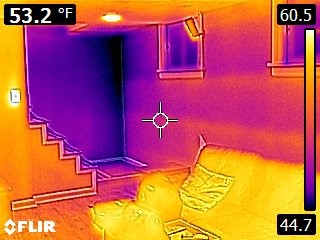This is the last part of a 3 part blog on thermal imaging and the home inspection. The first 2 blogs focused on basics of infrared thermography, and the primary benefits of utilizing thermal imaging during the home inspection. Today’s blog focuses on limitations of thermal imaging during the home inspection.
 Although thermal imaging is a great resource for anyone buying a house, there are certain limitations to be aware of before paying for this service:
Although thermal imaging is a great resource for anyone buying a house, there are certain limitations to be aware of before paying for this service:
- Exterior temperature – Since the whole premise of the Infrared camera is reading temperatures, if there is not a 15-20 degree temperature differential between the interior and exterior of the house, this can certainly limit what can be seen with
the camera. This is especially true of finding issues with air movement in the house. For much of the year, this is not a problem (depending on what part of the country you live in), but spring and fall can be challenging to have these differences. - Seeing Behind Walls/Materials – There is a common misconception that Infrared cameras are able to see behind drywall, brick, or any other material. As already discussed, the Infrared camera is only taking surface temperature readings. So, this means we can not know for sure what is going on behind walls, only speculate based on what’s happening on the surface. This is also true for houses that have a lot of furniture, pictures, and personal possessions that are blocking the wall surfaces. Almost all home inspectors will not move personal belongings of the sellers when doing an inspection or thermal imaging.
- Being definitive with the Thermal Image – As the infrared camera can only provide surface temperature readings, there will always be some possible variances in terms of interpreting the images. A well trained thermographer will do their best to determine the reason for potential concerns in the image, and will always use a moisture meter before making statements
regarding moisture intrusion, but sometimes it will be difficult for us to be definitive. - Poorly trained operator – As we have discussed, there is a lot behind the science of infrared thermography, various types of cameras, and situations that arise in a house that are not clear to diagnose. All these factors can have an impact on an operator that is not properly trained on their equipment, or how to properly interpret the infrared pictures. There are some excellent schools and classes available to home inspectors, so make sure anyone you hire has had proper training/certifications.
I hope this has shed some light on infrared thermography, and why this technology is becoming such an
important part of the home inspection process.


